 |
Kanchipuram is 71km (45 miles) southwest of Chennai on the Vegavati
River, and 64km west of Mamallapuram.
|
 |
It is said that "Ka" (Brahma)
"anchi" (worshiped) Lord Vishnu at this place and that
is why the city was given the name Kanchipuram. Puram means "city."
|
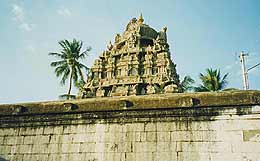 |
Kanchipuram is known as the "Golden
City of Temples." It is considered one of the seven main sacred
cities of India. Varanasi, Haridwar, Ujjain, Mathura, Ayodhya and
Dvaraka are the others. |
 |
Kanchipuram is believed to give eternal
happiness to one who goes there. |
 |
It has over one hundred temples now, but at one time it is said
to have had about one thousand.
|
 |
Ramanujacharya lived in Kanchipuram
during his youth. |
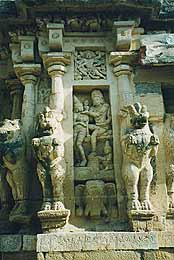 |
Four of the Alwars-Pey Alwar, Poygai Alwar, Bhutatt Alwar, and
Thirumalisai-were born within 50 miles of Kanchipuram.
|
 |
Sri Chaitanya visited Kanchipuram 500
years ago. |
 |
The city is divided into two main parts-Siva-kanchi,
which is the northern suburb, and Vishnu-kanchi, which is the extreme
east section of town. There is a group of Jain temples south, across
the river. Kailasanatha and Vaikuntha Perumal temples were the most
important temples built by the Pallavas. Varadaraja, Kamakshi, and
Ekambareswara temples were originally built by the Cholas, but were
added onto by the Vijayanagar and Nayaka rulers. |
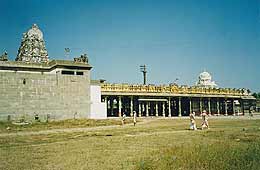 |
The temples are well spread out across the city and you need
at least four hours to see the major ones.
|
 |
There are thirteen Divya Desam temples
in the area of Kanchipuram. If you visit these temples you should
take into consideration that some of the less popular temples may
have the same priest doing the worship at more than one temple.
This means that you may come to one of these temples and it may
be closed. If possible, it is best to try to find a rickshaw driver
who knows what time each temple is open. |
 |
Most of the temples are open from sunrise to 12.30 pm and from
4 pm to sunset. Many temples restrict entry to Hindus only.
|
 |
Kanchipuram was the capital of the Pallavas
rulers from the 7th to 9th centuries. It was also important during
the Chola, Vijayanagar, and Nayaka periods. It is an ancient place.
It was mentioned in the Mahabhasya, written by Patanjali in the
2nd century BC. |
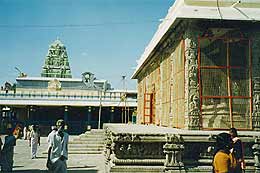 |
Inside of this pillar hall is a museum. |
 |
The shade of this mandapa creates nice
place for rest and refreshement. |
 |
Sri Varadaraja Temple
This is a major Vishnu temple built by the Vijayanagar kings in
the 12th century. It is counted along with Tirupati and Sri Ranganatha
(in Srirangam) as one of the major Vaishnava temples in South India |
 |
Varada means the "bestower of benedictions,"
and raja means "king." Thus, Varadaraja means the "king
of those who give benedictions." |
 |
Brahma's Yajna
It is said that once Saraswati asked her husband, Lord Brahma: "Who
is greater, Lakshmi or I?" Brahma replied that Lakshmi was
definitely better. Hearing this reply, Saraswati left her husband... |
 |
...At this time Brahma was preparing
to do a big sacrifice. When his consort, Saraswati, refused to participate
in the sacrifice, Brahma began the sacrifice alone. Then in great
anger, Saraswati transformed herself into the fast-flowing Vegavati
River and came rushing towards the yajna (sacrifice) area. Upon
Brahma's appeal for help, Lord Vishnu laid himself across the river's
path and foiled goddess Saraswati's efforts... |
 |
...She also tried to stop the yajna
in other ways. At the end of the yajna, Sri Varadaraja emerged from
the yajna. At Brahma's request Lord Varadaraja agreed to stay in
Kanchipuram in that form and give darshan to his devotees. |
 |
Ananta-tirtham, the temple tank, is north of the 100 pillar mandapa
hall.
The original deity of Lord Varadaraja (Atti Varadar), who is
said to have been installed by Lord Brahma himself, is in a silver
casket inside the temple tank. The deity is taken out every forty
to fifty years for 45 to 48 days (some say 10 days). The last
occasion was in 1979 and the next will be around 2019...
|
 |
The story is that Lord Brahma had Visvakarma, the architect of
the demigods, make a wooden deity of Lord Varadaraja. The utsava-murti
is said to have emerged from Lord Brahma's sacrificial fire. It
was felt that the wooden deity would be ruined if constantly exposed
and worshiped. Therefore the deity was immersed in the temple
tank, and a granite deity was installed in its place.
|
 |
If pilgrims wants to touch the Deities,
they must climb those iron stairs. |
 |
The consort of the Lord Varadaraja is Sri Perundevi Thayar (Lakshmi).
She has her own temple nearby.
|
 |
There is a beautiful garden inside
the walls of the temple. The Deity of Sri Perundevi Thayar goes
every Friday to this garden and there is a festival there. |
 |
The 100 (actually 96) pillar mandapa, which has exquisite sculptures,
is one of the beauties of India. Mainly avatars of Vishnu, and
scenes from the Mahabharata and Ramayana, are carved on the pillars.
|
 |
The main hall is supported
by giant pillars, each carved from a different rock. There are also
riders on horseback, beautiful figures of Rathi and Manmatha, and
a massive chain carved out of a single stone. |
 |
Different forms of Lord Vishnu are on
the paintings on the walls. |
 |
There is a Narasimha deity when you
first enter the main temple area, called Yoga Narasimha Swami. |
 |
This temple has a 30m (100 ft) high
gopuram originally built in the 11th century and later renovated
in the 16th century by the Vijayanagar kings. |
 |
The temple covers about 23 acres, which
is one of the biggest areas covered by any temple in India. The
temple's outer walls are 365m (1200 ft) by 545m (1800 ft). |
 |
Ramanujacarya used to regularly come
to this temple in his youth. He is said to have met the great Vaishnava
acharya Alavandar for the first time in the courtyard of this temple. |
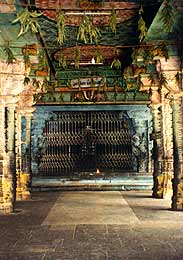 |
The main festival is the Brahmotsava
Festival in May-June, which is attended by hundreds of thousands
of people. During this festival the deity is carried in procession.
The main event is the Garudotsavam. |
 |
Non-Hindus are not allowed
in the temple, which means not into the second courtyard. Converted
Hindus may be allowed to enter, but are expected to wear traditional
dress and tilaka. |
 |
100 years ago this ashram was full
of brahmanas. |
 |
...But some are still there. |
 |
From the ceiling the pilgrims
can get an unussual blessing from Sun, Moon and... ...lizzard. |
 |
Kanchipuram is famous for
hand-woven silk fabrics and saris. The weavers use the highest quality
silk and pure gold thread. This place is known to be the best source
of high quality hand-woven silk items, and Varanasi is known to
be the best place for machine-made silk items. |
 |
Sri Ekambaranatha Temple
This temple is dedicated to Lord Siva and is the largest temple
in Kanchipuram. This temple is also known as the Ekambareswara
Temple. The Pallava kings built parts of the main temple, but
the rest of the temple complex was mainly built in the 16th and
17th centuries. It has the towering 60m (188 ft) high Raja Gopuram,
which was built by Krishna Deva Raya of the Vijayanagar Empire
in 1509.
|
 |
There is a mango tree behind the inner sanctum (main temple)
that is said to be 3,500 years old. It has four branches, said
to represent the four Vedas (sacred Hindu scriptures). Each leaf
of this tree is a different shape. The name of the deity itself
is believed to have been derived thus: Eka-Amra-Natha, meaning
the "Lord of the Mango Tree." The fruit from each branch
has a different taste.
|
 |
In the path around the tree is a Siva-linga
made of 108 small lingas and another one made up of 1008 lingas.
You should circle around the tree clockwise (the other way is considered
inauspicious). |
 |
The temple entrance. |
 |
Gopuram above the entrance gate. |
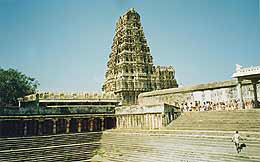 |
The huge linga is known as the Prithvi-linga,
or earth linga, and is one of the five element lingas of South India.
The other four are the Agni-linga (fire) at Thiruvannamalai, the
Appu-linga (water) at Jambukeswara, the Vayu-linga (air) at Kalahasti,
and the Akasha-linga (ether) at Chidambaram. |
 |
The story of the temple is that while
Lord Siva was meditating, Parvati playfully covered his eyes for
a moment. This resulted in the earth being covered with darkness
for years... |
 |
...This angered Siva who cursed Parvati
to go to earth and do severe penance. She came to earth and created
the earth linga and worshiped it under a single (eka) mango tree
in Kanchipuram... |
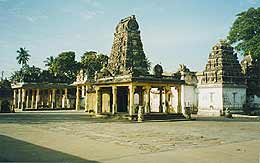 |
...Siva sent different obstacles to test Parvati's sincerity.
When he sent a flood, she clasped to the linga so tightly that
imprints were made on it.
It is believed that if a woman seeking a child worships here,
her desire will be fulfilled.
|
 |
Siva anad Parvati. |
 |
The sacred lake in the temple complex. |
 |
In one of the hallways of Ekambareswara
Temple there are 108 deities of Sankara acaryas. |
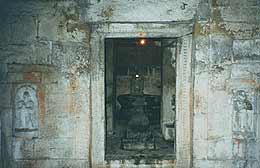 |
Siva-linga and sitting Nandi. |
 |
Parvati in Ekambareswara Temple. |
 |
Durga in Ekambareswara Temple.
|
 |
No two towers of the temple are opposite each other, nor are
the walls of the temple parallel to each other. There are almost
no right angles in the temple.
|
 |
There is a Vishnu temple within the
temple complex, which is one of the Divya Desams shrines. The Vishnu
deity in this temple is named Nilathingal Thundatthan Vishnu. |
 |
The temple has a 1,000-pillar hall (actually
540). |
 |
Most of the pillars are intricately
and beautifully carved. |
 |
This temple is really big, but not so
many pilgrims are comming there. |
 |
Kailasanatha Temple
Rajasimha Pallava built this sandstone temple, dedicated to Lord
Siva, in the late 7th century. His son, Mahendra Varman III added
the front later. It is the oldest temple in Kanchipuram |
 |
. It is one of the earliest examples
of Dravidian architecture and it is one of the most beautiful temples
in Kanchipuram. |
 |
The architecture resembles that of
the Shore Temple in Mamallapuram. There is a major festival here
during Siva-ratri in Feb/March. |
 |
Kailasanatha means "Lord of Mount
Kailash." It is famous for its sculptures. Most famous of these
is the sculpture of Ardhanariswara, who has a vina in her hand.
The outer wall of the temple has 58 small shrines showing different
aspects of Siva. |
 |
There are fresco-style paintings on
the inner walls of the shrine. |
 |
Place for meditation. |
 |
Sri Kamakshi Amman Temple
This temple is dedicated to goddess Kamakshi (Parvati). Kamakshi
means "one who has eyes full of love." Just in front
of Sri Kamakshi is the Sri Chakra. All worship and sacrifices
are offered to the Sri Chakra.
|
 |
Sri Kamakshi Amman Temple is one of the three main holy places
of Shakti worship in India, the other two being Varanasi and Madurai.
This temple has a golden gopuram and fine carvings. It was built
by the Cholas in the 14th century and the gopurams were built
during the Vijayanagar period. The gopurams are painted a variety
of bright colors.
|
 |
Sri Ulagalandar Temple
This temple is dedicated to Trivikrama (Vamana), who is called
Sri Ulagalandar, "the Lord who measured the world with his
three steps." This deity is nearly 11m (35 ft) in height.
Trivikrama is another name for Lord Vamana, who begged from Bali
Maharaja the amount of land that he could cover in three steps.
|
 |
The right foot of the deity is in a lifted position, indicating
that the Lord has already covered the earth and heaven. His left
foot is pressed on the head of Bali Maharaja. A lamp, fixed to
a big stick, is used to enable one to get a full view of the deity.
This temple has four Divya Desams shrines in it-Peragathan (Sri
Ulagalandar) and Ooragam (always referred to together), Neeragham,
Karagham, and Karvannam shrines. The shrine of Adi Sesa, called
Ooragam, is next to Ulagalandar Perumal. Ooragam means snake.
Adi Sesa is the divine snake used as a couch by the Lord.
|



































































